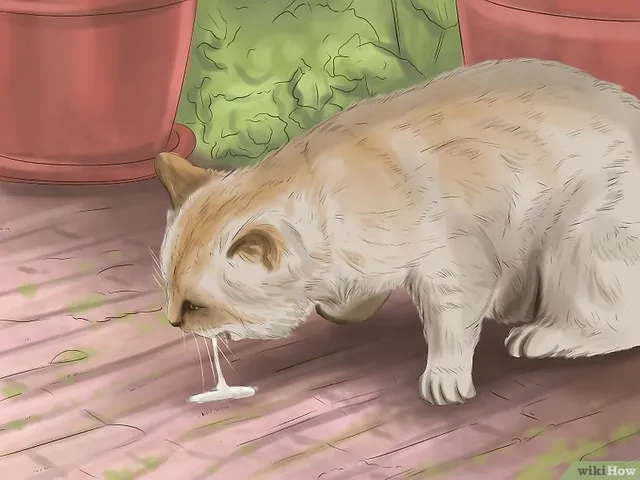So sad my neighbors cat died of poison 😭😭. Cat lovers please read this little research.
This little research might helps the those of us who love cats, I am a cat lover myself😍😍😍
Common Cat Poisons

Image source: wikihow
There are many ways that cats can get poisoned by ingesting things commonly found around the home. You can find additional information on Human Foods to Avoid for Cats and Toxic Plants for Cats.

Image source: unsplash
Medications
Aspirin:
The doses recommended in cats for relief of pain and fever is 10mg/kg every 48 hours. The toxic dose is 80 to 120 mg/kg for 10-12 days. The signs of aspirin toxicity in cats are dose-dependant and may include anorexia, vomiting, gastric haemorrhage, anaemia and hyperthermia.
Paracetamol: Cats are extremely sensitive to paracetamol toxicity. The feline toxic dose is 50 to 100 mg/kg. One regular strength tablet may be toxic to a cat, and a second ingested 24 hours later may be lethal. The signs of toxicity are brown gums, difficulty breathing, blood in the urine, jaundice and swelling.
Ibuprofen: The toxic effect of ibuprofen depends on the dose, the number of doses ingested and age of the cat. It is known that an acute ingestion of 50 mg/kg will produce a toxic effect. The signs of ibuprofen toxicity in cats are vomiting, depression, anorexia and diarrhoea.
Human topical pain medication: containing the nonsteroidal anti-inflammatory drug (NSAID) flurbiprofen. People using these medications should use care when applying them in a household with pets, as even very small amounts could be dangerous to these animals. There have been reports of cats that became ill or died after their owners used topical medications containing flurbiprofen on themselves to treat muscle, joint, or other pain. The pet owners had applied the cream or lotion to their own neck or feet, and not directly to the pet. Cats can come in contact with creams by rubbing up against their humans, or by licking the area the cream was applied to. They could also come in contact if humans pet their cats after applying the cream to themselves.
Other medications that should not be given to your cat as they can be potentially lethal, even in small doses, include:
Antidepressants–
can cause vomiting and lethargy with certain types leading to serotonin syndrome.
ADHD medications – act as a stimulant and dangerously elevate heart rate, blood pressure and body temperature.
Anti-cancer drugs.
Anti-diabetics
– cause a major drop in blood sugar levels causing disorientation, lack of coordination and seizures.
Cold medicines – acts as a stimulant causing elevated heart rates, blood pressure, body temperature and seizures.
Vitamin D derivatives– cause life-threatening spikes in blood calcium levels in pets that can lead to kidney failure.
Diet pills.
Muscle relaxants
– can impair the central nervous system and lead to death.
Household hazards
Ant baits:
These contain boric acid which is toxic to cats if eaten in a large amount. Ant baits have a sweet smell and taste to attract ants but it also appears to attract cats.
Antifreeze (ethylene glycol): Antifreeze is a common cause of poisoning in small animals. Cats will seek out antifreeze as they find its smell and taste appealing. A lethal dose of antifreeze is 1.5 ml/kg. The signs of antifreeze poisoning has three phases:
Phase 1 includes a drunken appearance which occurs within 1 hour of ingestion.
Phase 2 is heart failure which occurs within 12-24 hours of ingestion.
Phase 3 is renal failure, vomiting, depression, renal pain, hypothermia, coma and death.
Fertilisers:
Fertiliser products generally contain varying amounts of nitrogen (N), phosphorous (P) and potassium (K) compounds. They may be in liquid, granular or solid form and contain additives such as herbicides, insecticides and fungicides. Since fertilisers are usually a combination of ingredients, the effects of ingestion may vary. In general, they cause mild to moderate gastrointestinal irritation which may present signs such as vomiting, diarrhoea, hypersalivation and abdominal pain. Symptoms can be more severe if a larger amount is ingested and they may also be caustic, causing irritation of the lining of the gastrointestinal tract.
Lead:
Lead is not a common toxilogical problem but it may occur from ingestion of lead-containing dust or paint when grooming their contaminated coat. The signs of chronic, low level, lead poisoning include vomiting, abdominal pain, anorexia and diarrhoea while the acute signs are convulsions, blindness and tremors.
Rodenticides (rat or mouse bait): These are a common cause of cat poisoning. Most rodent poisons use anti-coagulants that kill the animals by causing uncontrollable bleeding. These baits are designed to attract animals so consider the use of them very carefully and try to use alternatives where possible. Signs of rodenticide ingestion appear one to four days after ingestion, they include depression, weakness, coughing and staggering. Most people don't realise that eating a poisoned rodent can also poison your cat.
Insecticides:
These usually contain organophosphates and carbonates which are highly toxic to cats. Signs of ingestion include vomiting, diarrhoea, hypersalivation, muscle tremors and seizures.
Molluscacides (snail and slug bait): Molluscacides come in a variety of forms and may be mixed with other toxins. Ingestion can be fatal and there is no antidote. The effects of ingestion include anxiety, elevated heart and respiratory rates, uncoordination, severe muscle tremors and death.
What to do if your cat is poisoned
Don't panic. Rapid response is important, but panicking can interfere with the process of helping your pet.
Take the time to safely collect and have at hand any material involved. This may be of great help to your vet, as they determine what poison or poisons are involved. Also, collect in a sealable plastic bag any material your pet may have vomited or chewed.
If you witness your pet consuming material that you suspect might be toxic, do not hesitate to seek emergency assistance, even if you do not notice any adverse effects. Sometimes, even if poisoned, an animal may appear normal for several hours or days after the incident.
Do not try to make your cat vomit unless instructed to do so by your veterinarian.
The information on this page was gathered from the ASPCA website, the RSPCA knowledge base, the Purina website and the Cornell University – Department of Animal Science website.
Source: agriculture

Image source: unsplash
Most cats give birth to a litter of between one and nine kittens. The largest known litter ever produced was 19 kittens, of which 15 survived
Wow, that's great, Cat lovers😍